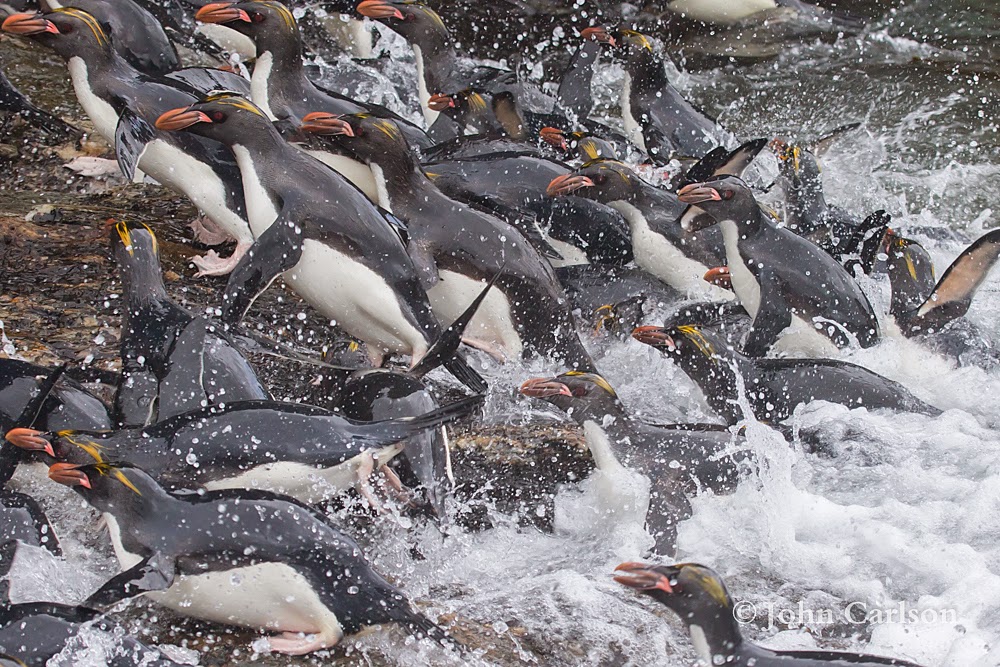 |
| Zodica cruise - Saint Andrews Bay, South Georgia 1/24/15 |
I am going to stick specifically penguins today. There is plenty of information concerning penguins available from other sources, including very good new book Penguins: The Ultimate Guide (which I will review in greater detail in a future post), so I am not going to delve into details and facts on this post and I will stick to photos of the species we observed.
Many travelers to Antarctica come to specifically see penguins and this trip was good for those travelers.
The first species I am going to present is the Adelie Penguin. This is the species I previously worked with the most and I have a soft spot for these tough little creatures. Unfortunately we did not see many Adelies on this trip. They are declining rapidly on the Antarctic Peninsula and the only place we were able to observe them at a breeding colony was on Peterman Island, where a few pair still manage to hang on. We did find quite a few groups along the heavy pack ice edge in the Weddell Sea however. The Weddell was stuffed full of pack ice this last summer - more than I have ever observed and the ice loving Adelies were common along the ice edge.
 |
| Adelie Penguins - Weddell Sea |
We were able to observe a number of Chinstrap Penguins on this trip. We visited breeding colonies on South Georgia and on the South Shetland Islands and also observed a number of individuals at scattered locations on the Antarctic Peninsula.
Gentoo Penguins are now the most common penguin encountered on cruises to the Antarctic Peninsula and we visited a number of colonies there, as well as in the Falkland Islands. In fact, unless all you want to see are Gentoos, it would be a benefit to pay attention to the detailed itinerary for your trip to Antarctica. Some agendas result in only visits to places where only Gentoos are found.
One of the high points for me was the chance to visit the King Penguin colonies on South Georgia again. We visited a number of locations in South Georgia where they breed and I enjoyed seeing them again. Unfortunately we were unable to visit the main part of the colony at Saint Andrews Bay this year because the glacial meltwater stream that we need to cross was flowing way to heavy and fast to get across. The high flows were due to the very warm temperatures we experienced for a couple of days leading up to our stop there.

Many of the birds were going through their annual molt, while others looked just fine.


We did find one lone Emperor Penguin too. As I noted above, the pack ice in the Weddell Sea was extraordinary this year so we were only able to cruise along the edge of the pack just east of the peninsula. As we were cruising along the edge the Captain exclaimed that he had found an Emperor just ahead. I was doubtful as was our other main naturalist aboard the ship because the bird in question just did not look big enough for an Emperor. Even when we got close it just didn't look right to us. However, once we were able to get better looks and zoom in on our photos we realized that it was indeed an Emperor - just a very young one that wasn't even close to adult size. Still an Emperor Penguin though and the Captain was right once again.
We had a great afternoon with Macaroni Penguins at one of our stops on South Georgia near Cooper Bay. There are a couple of colonies of Macs here and we were able to get wonderful views of these birds from the Zodiacs.
We observed quite a few Magellanic Penguins in the Beagle Channel every time we transited in or out of the channel. On our first stop in the Falkland Islands on Saunders Island, there were a few birds near a Rockhopper Penguin colony where we were able to observe them up close on land.
We also got to see a couple of colonies of Rockhopper Penguins at Saunders Island.

The photo above shows the grooves that have been worn into the rocks by generations of Rockhoppers digging in with their claws as they slide down these slopes.
|





















































2 comments:
Great stuff, John!
This is an epic post! Sooooo many penguins and of so many species! Beautiful photography, absolutely stunning. That photo of all the King Penguins crammed into the frame would be an insane jigsaw puzzle.
Post a Comment